Epic Hike on Ben Nevis: Scotland’s Highest Mountain
Ben Nevis, Scotland’s Highest Mountain stands at an impressive 1,345 meters (4,413 feet). It’s the tallest peak not only in Scotland but across the entire United Kingdom and the British Isles. This make it the true king of hills. Situated in Lochaber’s Highland region, at the Grampian Mountains’ western edge, this towering giant attracts 130,000 visitors annually. Most hikers take the Mountain Track from Glen Nevis by following a popular path to the top.
Why Ben Nevis is a Haven for Adventurers
It is not just a mountain that rises high above the others. Ben Nevis is a center of attraction for those who are into adventurous activities. Its north face rises abruptly to 700 meters (2,300 feet), featuring vertical cliffs which makes it a paradise for rock and ice climbers. It has very steep roads that make it highly suitable for professional climbers who want to attempt their skills.
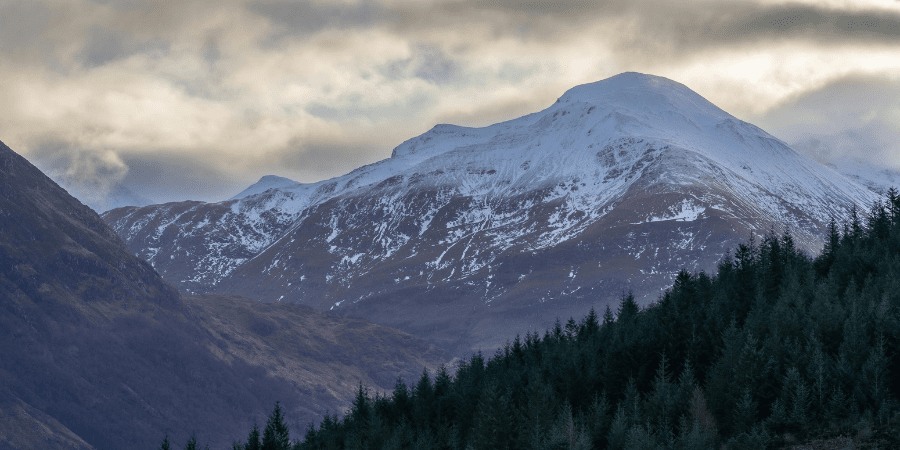
The Classic Mountain Trail is the busiest, being approximately 10 miles long and taking hikers roughly 7-9 hours to hike. The trail from the visitor center is easy to moderate, but the views and summit route reward your effort.
The Ideal Time for Your Ascent
For a good hike, attempt it in summer (June to September) for favorable weather and ample daylight. However, mountain conditions can change suddenly, so always check the weather forecast beforehand. Ensure the gear you carry is appropriate for the conditions, as the weather at the summit can be quite aggressive.
What to Expect at the Ben Nevis the Scotland’s Highest Mountain
On Ben Nevis, you can, of course, get to the top, which is a beautiful view of the surrounding area. There are many stunning landmarks, and on a sunny day, it is possible to make out the Isle of Skye and parts of Northern Ireland. This is one of the most beautiful attractions in the country with many hikers and nature lovers regarding it as one of the places they would love to visit before they die. Thus, regardless of the level of professional experience and the frequency of visitors’ one can mention that the Ben Nevis is the crown of any travel in Scotland.
Preparing for Your Adventure of Highest Mountain Ben Nevis
Ben Nevis the Scotland’s Highest Mountain is a great temptation for those who seek a challenge in hiking. Reaching a higher place is fun, but to ensure that you will not have a hard time going up, it is very important that you prepare yourself and that you should be aware of the right thing to do while hiking. Therefore, it can be rightly noted that planning is a very important aspect of achieving good results, so start with a good plan and don’t be hasty.
- Research the routes and always check the weather forecasts. Having a good trail map will help you follow your ascent smoothly. Equip yourself with the necessary equipment like sturdy clothing and effective navigation tools.
- Begin your hike early in the day to make use of the limited daylight hours. This is particularly important in winter or late autumn, when daylight is short.
- Dressing in layers is key for a successful climb. The weather can be unpredictable, so wear waterproof and windproof clothing to protect yourself against sudden rain and strong winds. Invest in good-quality hiking boots that are sturdy and comfortable, with proper ankle support. Ensure you break in your footwear to avoid painful blisters during your climb.
- Navigation is vital on Ben Nevis, so always carry a map, compass, or GPS device, and make sure you know how to use them. The conditions of the mountains can change quickly, and getting lost in the fog or low visibility is a real risk. It’s better to hike with a companion or in a group for added safety, especially if you are less experienced. Watching out for each other can make the climb safer and more enjoyable.
- Follow the principles of Leave No Trace and respect the natural environment of Ben Nevis. Make sure to carry out all your trash and waste, and avoid damaging the stunning surroundings. Be ready for rapid weather changes, as the mountain can have severe and unpredictable weather. Stay aware of the conditions, and turn back if visibility becomes too poor or if you feel unsure.
- Show respect to the mountain and be cautious, particularly in exposed areas where the risk of falling is higher. Ben Nevis demands a certain level of respect and preparation, so avoid taking unnecessary risks.
By following these simple steps, you’ll have a safer and more enjoyable climb on Scotland’s most iconic peak. Happy hiking and stay safe!
Essential Safety Tips for Climbing Ben Nevis
Climbing Ben Nevis requires enough preparation and the right equipment to ensure a safe and enjoyable ascent. Here’s a checklist of items you’ll need:
- Appropriate Clothing: Dress in layers to adapt to changing weather conditions. Include a waterproof jacket, trousers, sturdy hiking boots, moisture-wicking base layers, warm insulation layers, gloves, and a hat or beanie.
- Navigation Tools: Carry a map, compass, or GPS device to navigate the trails. Familiarize yourself with the route before starting the climb.
- Food and Water: Pack enough food to sustain your energy throughout the climb, such as high-energy snacks, sandwiches, and fruits. Bring an adequate supply of water or a water purification system to refill from natural sources along the route.
- Backpack: Use a comfortable and appropriately sized backpack to carry your gear and supplies. Ensure it has supportive straps and is suitable for hiking.
- First Aid Kit: Carry a basic first aid kit with essential items like plasters, bandages, antiseptic cream, pain relievers, blister treatment, and any personal medications.
- Headlamp or Torch: Even for daytime hikes, having a headlamp or torch is essential in case your hike takes longer than anticipated.
- Weather Protection: In addition to clothing, bring items like sunglasses, sunscreen, and a hat to protect against sun exposure. Pack extra layers in case of sudden weather changes.
- Mobile Phone and Power Bank: Carry a fully charged mobile phone for emergencies and use a power bank to ensure it stays charged throughout your hike.
Routes to the Summit: Finding the Best Path for You
The three main walking routes up Ben Nevis are:
- Mountain Track (also known as the Tourist Track or Pony Track): This is the most popular and easiest route, suitable for beginners.
- Carn Mor Dearg Arête: A more challenging ridge climb, recommended for experienced hikers and physically-fit hillwalkers.
- North Face Route: A technically demanding route for expert climbers, with a steeper ascent and more advanced scrambling sections.
The Mountain Track: Ideal for Beginners
If you’re new to hiking, the Mountain Track, also known as the Tourist Track or Pony Track, is the perfect choice to reach the summit of Ben Nevis. This route, starting at the Ben Nevis Visitor Centre near Fort William, is designed for beginners. The climb begins with a steep ascent that leads to the halfway lochan, or Lochan Meall an t-Suidhe, where you can catch your breath and enjoy the scenery.
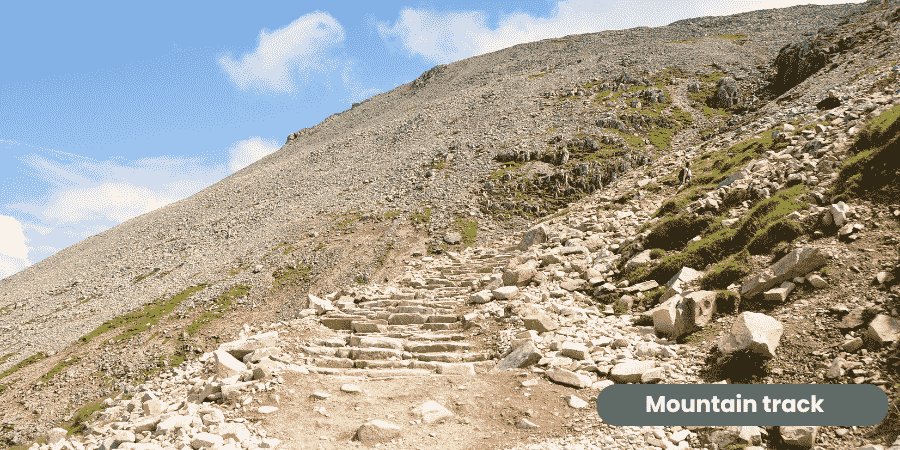
The path then winds its way with zig-zag sections that guide you to the summit. This is the easiest route up the mountain, offering a chance to enjoy the hike without needing advanced hiking skills.
Rewarding Views at the Summit
Reaching the summit of Ben Nevis is an incredible accomplishment. Once you reach the top, you’ll find a cairn marking the highest point. On clear days, the view is awe-inspiring, with 360° panoramic vistas that extend all the way to Northern Ireland. You’ll also see other famous peaks like Ben Lomond, Morven, and the Torridon hills in Caithness.
Another interesting feature of the summit is the Old Observatory, which provided vital meteorological data between 1883 and 1904. Though now in ruins, it offers shelter for hikers caught in bad weather.
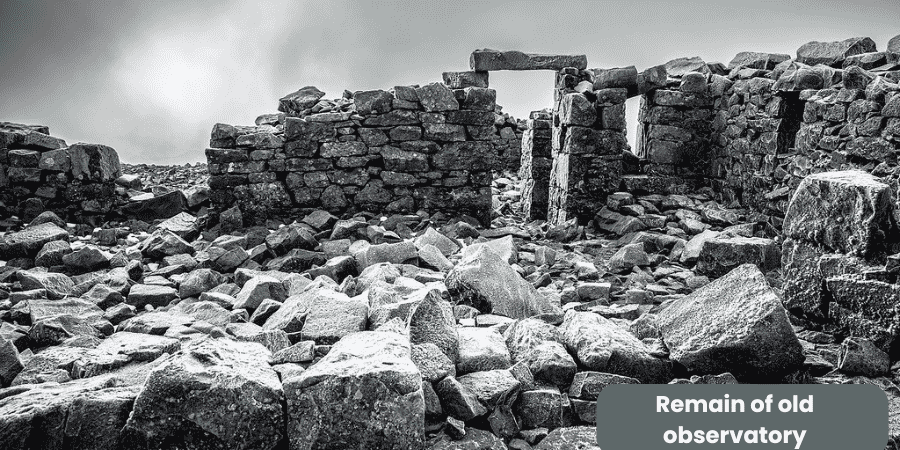
A More Challenging Route: Carn Mor Dearg Arête
For experienced hikers looking for a more challenging adventure, the Carn Mor Dearg Arête is a thrilling option. Only experienced scramblers and physically fit hillwalkers should attempt this ridge climb. The route starts from the North Face car park at Torlundy and crosses two Munros: Carn Mor Dearg and Ben Nevis.
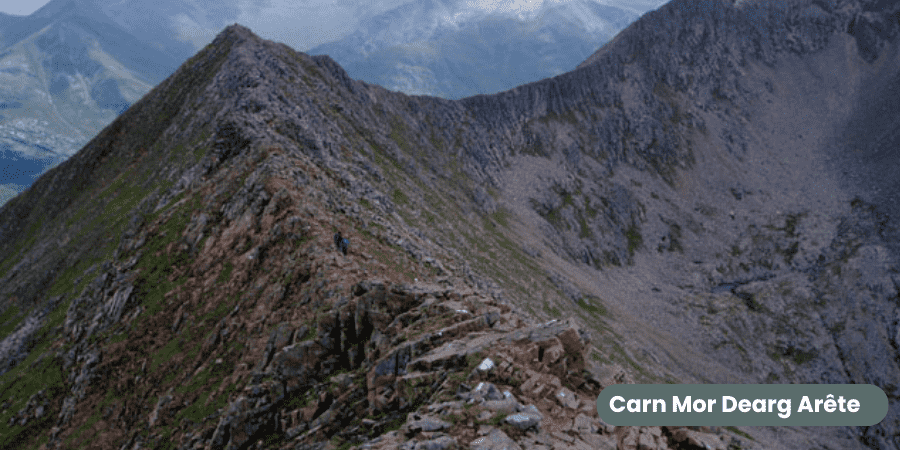
As you climb, you’ll encounter scrambling sections across boulders. This route takes about 10-11 hours and requires good navigation skills and a strong head for heights.
Prepare for a Strenuous Walk
The Carn Mor Dearg Arête is a longer, more difficult route than the Mountain Track. Expect a strenuous walk with several exposed sections. This trail demands stamina and the ability to handle difficult terrain, so make sure you’re physically prepared. Carry navigation tools like a map and compass, as conditions on the mountain can change rapidly.
On the way to the summit, you’ll pass the CIC Hut, a private shelter for mountaineers. It can offer shelter and a rest stop for those tackling the Carn Mor Dearg Arête. If you’re feeling worn out or need a break from the weather, this hut can be a lifesaver.
Before setting out, make sure to plan your hike thoroughly. Whether you’re taking the Mountain Track or the more difficult Carn Mor Dearg Arête, understanding the terrain and having a solid navigation strategy is essential. Prepare for scrambling and challenging weather conditions at any point during your hike.
Remember to bring plenty of water, high-energy snacks, and wear appropriate clothing, including sturdy boots for scrambling sections.
Other Activities Around the Highest Mountain the Ben Nevis
When it comes to hiking Ben Nevis, there are several routes that cater to different skill levels.
Ledge Route: A Steeper Alternative
Another exciting option is the Ledge Route, which also begins at the North Face car park. This route covers 7-8 miles (11-13 kilometers), typically takes 7-9 hours to complete and is a bit steeper than the Mountain Path. It features sections of scrambling and offers a more direct approach to the summit.
However, it’s less exposed than the CMD Arete, making it a solid choice for adventurous hikers looking for a challenge without the higher risks of exposure.
Tower Ridge and North Face Climbing Routes: For Experts Only
For those with advanced climbing and mountaineering skills, Tower Ridge and the North Face climbing routes offer the most demanding challenges on Ben Nevis. These routes begin at the CIC Hut or the North Face car park and cover rock climbing with technical and specialized equipment.
With a vertical ascent of 3,000 feet (900 meters), these routes are suited only for climbers with experience, and careful preparation and understanding of weather conditions are crucial for tackling these extreme climbs.
The Flora and Fauna of Ben Nevis
Flora of Ben Nevis the Scotland’s Highest Mountain
Ben Nevis boasts a unique range of vegetation. The upper slopes host hardy alpine plants like moss campion, alpine lady’s mantle, and mountain sorrel, adapted to high winds and low temperatures. In summer, vibrant wildflowers add colorful touches to the rocky landscape, with heather and cotton grass creating stunning patches of purple and white.
Lower slopes are blanketed with heather, bog mosses, and cotton grass, thriving in the acidic soil. These plants provide essential food sources and habitat for the creatures of the mountain.
Fauna of Ben Nevis the Scotland’s Highest Mountain
Ben Nevis is home to a variety of bird species, including the golden eagle, often seen soaring above, and the red grouse, which hides in the heather. Ptarmigan and snow bunting change their plumage to blend with the snow, offering great camouflage in the winter.
In addition to birds, mammals like the elusive mountain hare can be spotted, especially in winter when their white fur blends in..
The mountain’s fragile ecosystem is heavily reliant on the efforts of those dedicated to conservation. Efforts are made to protect this environment for future generations by carefully balancing vegetation, wildlife, and climate.
Visitors to Ben Nevis are encouraged to stick to established paths and avoid trampling the sensitive vegetation, contributing to the ongoing conservation efforts.
Facts about Ben Nevis:
- The Ben Nevis Scotland’s Highest Mountain stands at 1345m (or 4,413 ft), making it the highest mountain in Britain.
- Located in the Ben Nevis and Glen Coe National Scenic area, it is a Site of Special Scientific Interest.
- The summit is 10°C cooler than at the base.
- The first recorded ascent of Ben Nevis was on 17 August 1771 by James Robertson, an Edinburgh botanist.
- The summit observatory was built in summer 1883 and remained operational for 21 years.
- The Ben Nevis Race has been held since 1951, with the fastest runners completing it in about 1½ hours.
Myths:
- The Hidden Giants: Local folklore tells of giants who once inhabited Ben Nevis. Legend has it that these mythical beings carved the valleys and shaped the landscape which create the dramatic features seen today.
- The Ghost of the Observatory: Some believe that the summit observatory is haunted by the spirit of a former observer, who roams the ruins, particularly during the misty days when visibility is low. This mysterious figure is said to be seen from time to time which linger near the summit.
- A Site of Spiritual Power: Another legend suggests that Ben Nevis is a place of ancient spiritual significance that believed to be a sacred site for ancient Celtic rituals. Some visitors still come to meditate and connect with the mountain’s supposed mystical energy.
- The “Snow Witch” Legend: Locals tell tales of a “snow witch” who resides at the top of Ben Nevis. According to the legend, she controls the unpredictable weather of the mountain, sending storms and mist when visitors get too close to the summit.
Final Thoughts: Why Climbing Ben Nevis is Worth It
Climbing Ben Nevis, the highest of all the mountains in Scotland, is a rewarding challenge that attracts hikers from around the world. Known for its famous status, the hike offers stunning views of the Highlands of Scottish and a chance to experience the natural beauty of the mountain. While the climb may not be as tall as the highest mountains globally, the impressive summit gives a real sense of accomplishment. Although Scotland’s highest peak, Ben Nevis, offers breathtaking views of the Scottish Highlands, it is comparable to other famous mountains worldwide, such as Huangshan Mountain China. Both mountains are renowned for their cultural significance and natural beauty, drawing tourists and nature enthusiasts from all over the world.
FAQ related to Ben Nevis
- How long does it take to climb Ben Nevis?
The time it takes to climb Ben Nevis varies depending on your fitness level, the conditions of the weather, and how many breaks you take to admire the views. Typically, it takes between 7-9 hours to complete the climb, with the ascent to the summit usually taking between 3.5 to 4.5 hours.
- How tough is it to climb?
Climbing Ben Nevis is considered an arduous climb. It’s a long journey, and the next day, you might experience stiff legs, but the accomplishment of reaching this tallest mountain in the United Kingdom makes it all worthwhile.
- How high is it?
At a height of 1,345 m, Ben Nevis towers above landmarks like the London Eye (135 m) and Big Ben (96 m).
- Do I need a map and a compass?
Yes, even though the Mountain Track is relatively easy to follow on a clear day, it is important to have both a compass and a map. These tools are pivotal, especially if the weather turns and visibility becomes poor.
- Can I camp at Ben Nevis?
Camping on Ben Nevis itself is not advisable due to the uneven terrain, busy walkers during the summer, and exposed peaks. However, you can camp at the Glen Nevis Campsite which is located near the foot of the mountain, just a short walk from the Mountain Track start.
- When is the best time of year to climb?
To climb the Ben Nevis summer is the best time, as you’re likely to enjoy sunshine and clear views. However, snow can be found at any time of year, and if you’re planning a winter ascent, it’s important to be an experienced mountaineer and to check Mountaineering Scotland’s #ThinkWINTER guidance.
- What will the weather be like?
The weather on Ben Nevis can change rapidly which ranges from glorious sunshine to gale force winds. Temperatures at the summit can drop below freezing, so make sure to wear all-weather gear and check the mountain weather page before your hike.
- What should I bring?
It’s important to wear warm and waterproof clothing, and avoid cotton as it absorbs moisture. A good pair of walking boots is important, along with hiking tools like a compass, map, torch, whistle, food, and water. Don’t forget to take your litter back down with you, as there are no bins on the mountain.
- Is Ben Nevis suitable for children to climb?
While Ben Nevis is suitable for children, especially those who are prepared for all weather conditions and enjoy a challenge, the Carn Mor Dearg Arete route is not recommended for younger hikers due to its difficulty.
- Can I bring my dog?
Yes, you can bring your dog, but make sure it’s kept on a lead, especially in areas with uneven terrain, scree, or loose stones. Some parts of the mountain may be tricky for dogs to navigate.
- Where can I stock up on supplies?
Before starting your climb, you can pick up maps, snacks, and information at the Glen Nevis Visitor Centre, which is located at the base of the mountain. Fort William also has several outdoor shops where you can find any essentials.
- Can I do a guided walk of Ben Nevis?
Yes, there are several guided walks available if you prefer local knowledge or need extra confidence during your hike. The guides can share interesting facts and help you explore the best viewpoints along the way.
- How do I get there?
To get to Ben Nevis, head to Fort William, which is located at the foot of the mountain. It’s about 2-3 hours from Glasgow and 3-4 hours from Edinburgh, depending on traffic conditions. You can also take a direct train from Glasgow or catch the Caledonian Sleeper from London Euston. Additionally, there is a direct CityLink 914 Bus Service from Buchanan Bus Station in Glasgow to Fort William Bus Station.

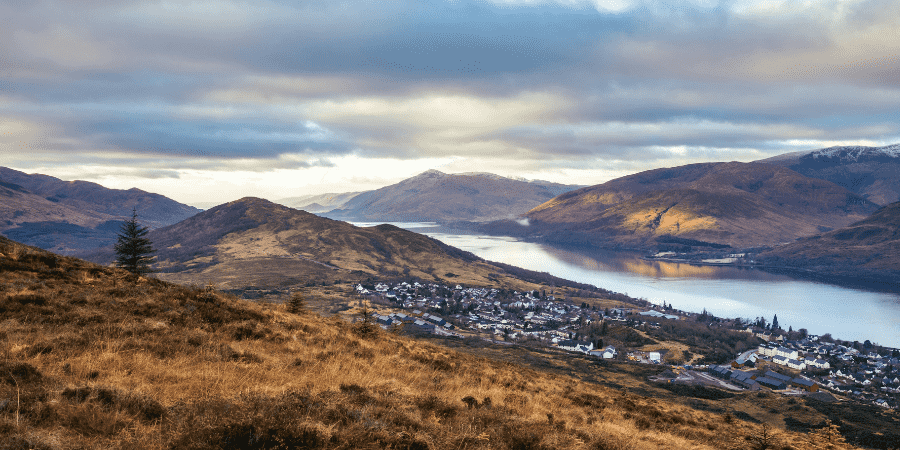
2 Responses
[…] Epic Hike on Ben Nevis: Scotland’s Highest Mountain […]
[…] Epic Hike on Ben Nevis: Scotland’s Highest Mountain […]